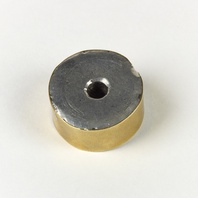
Viking Objects
Reproduction Copper Alloy-Edged Lead Weight
A lead weight edged with a copper alloy band.
Read More
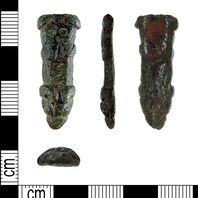
Viking Objects
Copper-Alloy Strap-End (DENO-E40172)
An incomplete copper-alloy strap-end decorated with zoomorphic motifs and stylised human or animal head. It has been identified typologically as belonging to Thomas Class B Type 4.
Read More
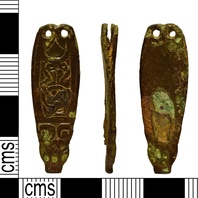
Viking Objects
Copper-Alloy Strap-End (NARC-033287)
An incomplete copper-alloy strap-end classified as Thomas’ Class A, Type 1, with zoomorphic terminal and Trewhiddle-style decoration. The decoration is composed of an incised pattern which depicts two semi-circular ears below which are two triangular eyes to either side of the head can be see, flanked by a forked central brow. The central panel bears Trewhiddle-style decoration depicting a beast with serpentine curvilinear tail.
Read More
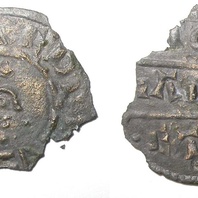
Viking Objects
Coin of Aethelred (1989-58/3395)
A silver penny of Aethelred I of Wessex was found in the mass grave at Repton and minted by a moneyer apparently called Liabinc. The location of minting is unknown. Aethelred I was King of Wessex from 865 until his death in 871. Aethelred’s reign coincided with the arrival of the Viking Great Heathen Army in England and he fought them with little success during their invasion of Wessex which began in 870. After his death, he was succeeded by his youngest brother, Alfred the Great, who carried on the war with the Vikings. Minting coins was a way of controlling the means of exchange within a kingdom and which created a more easily administered standardized system of trade. Moreover, the coins themselves were often used as propaganda, portraying symbols and statements that gave off a desired message. The Vikings later used the minting of coins to legitimize their own rule.
Read More
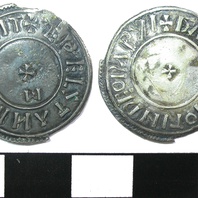
Viking Objects
Silver Penny (1914/543-1)
This silver penny of King Aethelstan, who was King of England from 927-939, was minted in Derby by the moneyer Gadierd between 937-939. It is not known where it was found. Moneyers were people who were permitted to mint money on behalf of the king. Minting coins was a way of controlling the means of exchange within a kingdom and which created a more easily administered standardized system of trade. Moreover, the coins themselves were often used as propaganda, portaying symbols and statements that gave off a desired message. The Vikings later used the minting of coins to legitimize their own rule.
Read More
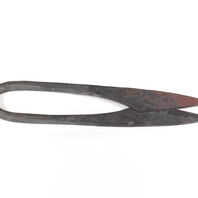
Viking Objects
Reproduction Shears
Shears were a common agricultural implement generally used to cut the wool off sheep but could also have been used as scissors in textile production. These are based on a number of originals uncovered during the excavations at Flixborough, Lincolnshire.
Read More
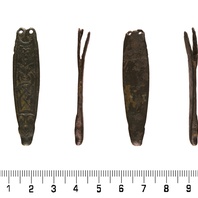
Viking Objects
Decorated Strap-End (WMID-2D6997)
A copper-alloy Thomas Class A Type 1 strap-end with a section at the top which splits into a ‘V’ shape. The strap-end is decorated with what seems to be a stylized face above some interlaced knotwork while the tip features a stylized beast head.
Read More
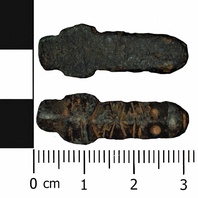
Viking Objects
Zoomorphic Strap-End (LANCUM-E11AB2)
This Thomas Class B, Type 4 strap-end has a pointed zoomorphic terminal moulded to represent an animal head with large semi-circular eyes and ears in Trewhiddle style. There are possible traces of niello in the recesses. .
Read More
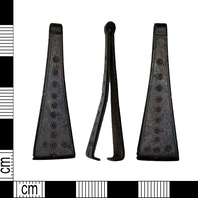
Viking Objects
Copper-Alloy Tweezers (LEIC-F41656)
A pair of copper-alloy tweezers found in Bassetlaw, Nottinghamshire. These feature a ring-and-dot stamped pattern with a tube at one end to accommodate a suspension loop. They would have been carried suspended from a brooch or belt. Tweezers were common personal items that people would have carried with them. They could be highly decorated.
Read More
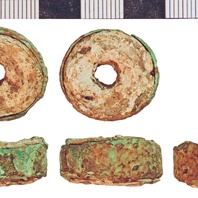
Viking Objects
Copper-Alloy Edged Lead Weight (NLM-E6E083)
A lead weight edged with a copper-alloy band. The distinction of weights by embedded objects or other embellishments in various media is a widely recognised feature of some early medieval weights. The object has also been identified as a spindle whorl, though this is less likely. If a weight, it is perhaps an indicator of the Scandinavian bullion economy. Weights are an important form of evidence for Viking Age commerce and the use of standards across the different economic systems within which Vikings were integrated. Many of the weights discovered, particularly ones in Ireland and those of Arabic type, suggest that a standardized system of weights existed in some areas. These standard weights, alongside standard values of silver, are what allowed the bullion economy of Viking occupied areas to function. A bullion economy was a barter economy that relied on the exchange of set amounts of precious metal in various forms, such as arm-rings or coins, for tradable goods, such as food or textiles. Each merchant would have brought their own set of weights and scales to a transaction to make sure that the trade was conducted fairly.
Read More
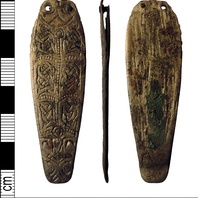
Viking Objects
Anglo-Saxon Zoomorphic Strap-End (NCMG 2003-27; T2001:2 ; 2002 T21)
A large silver strap-end with simple chevron decoration and six incised panels of ribbon knotwork divided by curved laddered frames. This strap-end is typical of ninth-century Anglo-Saxon design from the Yorkshire school. The border design is also found on the Trewhiddle type but due to its lower quality execution this strap-end is probably an imitation. Strap-ends came in various styles and were fairly common throughout the Viking world. They were used to decorate the ends of belts and to stop them getting damaged.
